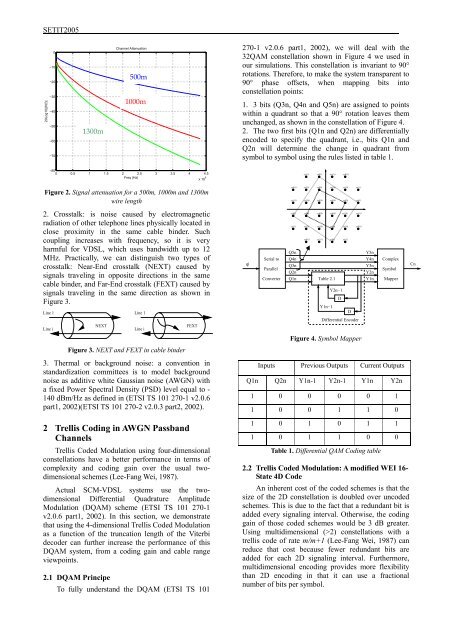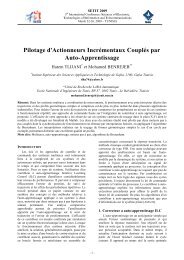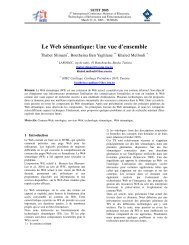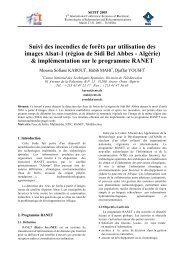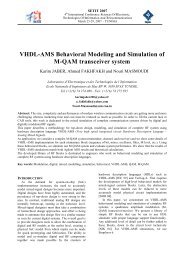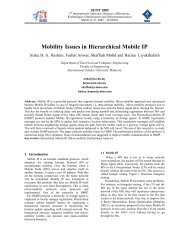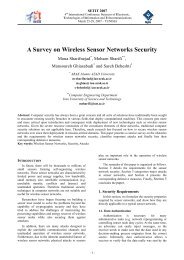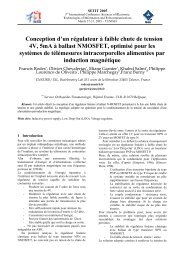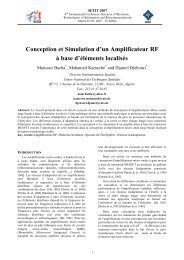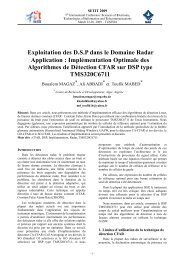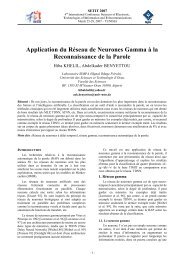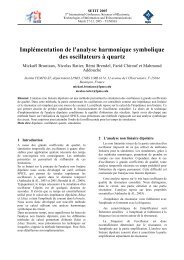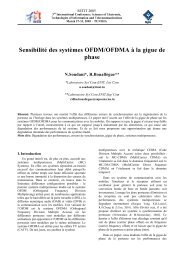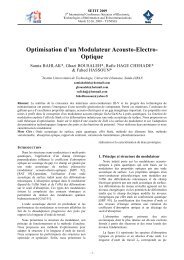Contribution of Multidimensional Trellis Coding in VDSL Systems
Contribution of Multidimensional Trellis Coding in VDSL Systems
Contribution of Multidimensional Trellis Coding in VDSL Systems
You also want an ePaper? Increase the reach of your titles
YUMPU automatically turns print PDFs into web optimized ePapers that Google loves.
SETIT2005<br />
20Log10(|H(f)|<br />
0<br />
−10<br />
−20<br />
−30<br />
−40<br />
−50<br />
−60<br />
−70<br />
1300m<br />
Channel Attenuation<br />
500m<br />
1000m<br />
270-1 v2.0.6 part1, 2002), we will deal with the<br />
32QAM constellation shown <strong>in</strong> Figure 4 we used <strong>in</strong><br />
our simulations. This constellation is <strong>in</strong>variant to 90°<br />
rotations. Therefore, to make the system transparent to<br />
90° phase <strong>of</strong>fsets, when mapp<strong>in</strong>g bits <strong>in</strong>to<br />
constellation po<strong>in</strong>ts:<br />
1. 3 bits (Q3n, Q4n and Q5n) are assigned to po<strong>in</strong>ts<br />
with<strong>in</strong> a quadrant so that a 90° rotation leaves them<br />
unchanged, as shown <strong>in</strong> the constellation <strong>of</strong> Figure 4.<br />
2. The two first bits (Q1n and Q2n) are differentially<br />
encoded to specify the quadrant, i.e., bits Q1n and<br />
Q2n will determ<strong>in</strong>e the change <strong>in</strong> quadrant from<br />
symbol to symbol us<strong>in</strong>g the rules listed <strong>in</strong> table 1.<br />
−80<br />
0 0.5 1 1.5 2 2.5<br />
Freq (Hz)<br />
3 3.5 4 4.5<br />
x 10 6<br />
xx111<br />
xx011<br />
xx110<br />
xx010<br />
Figure 2. Signal attenuation for a 500m, 1000m and 1300m<br />
wire length<br />
2. Crosstalk: is noise caused by electromagnetic<br />
radiation <strong>of</strong> other telephone l<strong>in</strong>es physically located <strong>in</strong><br />
close proximity <strong>in</strong> the same cable b<strong>in</strong>der. Such<br />
coupl<strong>in</strong>g <strong>in</strong>creases with frequency, so it is very<br />
harmful for <strong>VDSL</strong>, which uses bandwidth up to 12<br />
MHz. Practically, we can dist<strong>in</strong>guish two types <strong>of</strong><br />
crosstalk: Near-End crosstalk (NEXT) caused by<br />
signals travel<strong>in</strong>g <strong>in</strong> opposite directions <strong>in</strong> the same<br />
cable b<strong>in</strong>der, and Far-End crosstalk (FEXT) caused by<br />
signals travel<strong>in</strong>g <strong>in</strong> the same direction as shown <strong>in</strong><br />
Figure 3.<br />
L<strong>in</strong>e 1<br />
L<strong>in</strong>e i<br />
NEXT<br />
L<strong>in</strong>e 1<br />
L<strong>in</strong>e i<br />
Figure 3. NEXT and FEXT <strong>in</strong> cable b<strong>in</strong>der<br />
FEXT<br />
3. Thermal or background noise: a convention <strong>in</strong><br />
standardization committees is to model background<br />
noise as additive white Gaussian noise (AWGN) with<br />
a fixed Power Spectral Density (PSD) level equal to -<br />
140 dBm/Hz as def<strong>in</strong>ed <strong>in</strong> (ETSI TS 101 270-1 v2.0.6<br />
part1, 2002)(ETSI TS 101 270-2 v2.0.3 part2, 2002).<br />
qi<br />
Serial to<br />
Parallel<br />
Converter<br />
xx010<br />
xx110<br />
xx011<br />
xx101<br />
xx100<br />
xx001<br />
xx111 xx101 xx100<br />
Q5n<br />
Q4n<br />
Q3n<br />
Q2n<br />
Q1n<br />
xx010<br />
xx001<br />
xx100<br />
xx101<br />
xx111<br />
xx000 xx000 xx001 xx011<br />
xx000 xx000 xx100 xx110<br />
xx110<br />
xx001 xx101 xx010<br />
xx011<br />
Table 2.1<br />
xx111<br />
Y2n−1<br />
D<br />
Y1n−1<br />
D<br />
Differential Encoder<br />
Figure 4. Symbol Mapper<br />
Y5n<br />
Y4n<br />
Y3n<br />
Y2n<br />
Y1n<br />
Complex<br />
Symbol<br />
Mapper<br />
Inputs Previous Outputs Current Outputs<br />
Q1n Q2n Y1n-1 Y2n-1 Y1n Y2n<br />
1 0 0 0 0 1<br />
1 0 0 1 1 0<br />
Cn<br />
2 <strong>Trellis</strong> <strong>Cod<strong>in</strong>g</strong> <strong>in</strong> AWGN Passband<br />
Channels<br />
<strong>Trellis</strong> Coded Modulation us<strong>in</strong>g four-dimensional<br />
constellations have a better performance <strong>in</strong> terms <strong>of</strong><br />
complexity and cod<strong>in</strong>g ga<strong>in</strong> over the usual twodimensional<br />
schemes (Lee-Fang Wei, 1987).<br />
Actual SCM-<strong>VDSL</strong> systems use the twodimensional<br />
Differential Quadrature Amplitude<br />
Modulation (DQAM) scheme (ETSI TS 101 270-1<br />
v2.0.6 part1, 2002). In this section, we demonstrate<br />
that us<strong>in</strong>g the 4-dimensional <strong>Trellis</strong> Coded Modulation<br />
as a function <strong>of</strong> the truncation length <strong>of</strong> the Viterbi<br />
decoder can further <strong>in</strong>crease the performance <strong>of</strong> this<br />
DQAM system, from a cod<strong>in</strong>g ga<strong>in</strong> and cable range<br />
viewpo<strong>in</strong>ts.<br />
2.1 DQAM Pr<strong>in</strong>cipe<br />
To fully understand the DQAM (ETSI TS 101<br />
1 0 1 0 1 1<br />
1 0 1 1 0 0<br />
Table 1. Differential QAM <strong>Cod<strong>in</strong>g</strong> table<br />
2.2 <strong>Trellis</strong> Coded Modulation: A modified WEI 16-<br />
State 4D Code<br />
An <strong>in</strong>herent cost <strong>of</strong> the coded schemes is that the<br />
size <strong>of</strong> the 2D constellation is doubled over uncoded<br />
schemes. This is due to the fact that a redundant bit is<br />
added every signal<strong>in</strong>g <strong>in</strong>terval. Otherwise, the cod<strong>in</strong>g<br />
ga<strong>in</strong> <strong>of</strong> those coded schemes would be 3 dB greater.<br />
Us<strong>in</strong>g multidimensional (>2) constellations with a<br />
trellis code <strong>of</strong> rate m/m+1 (Lee-Fang Wei, 1987) can<br />
reduce that cost because fewer redundant bits are<br />
added for each 2D signal<strong>in</strong>g <strong>in</strong>terval. Furthermore,<br />
multidimensional encod<strong>in</strong>g provides more flexibility<br />
than 2D encod<strong>in</strong>g <strong>in</strong> that it can use a fractional<br />
number <strong>of</strong> bits per symbol.


